One of the main treatment options for a golfer’s elbow is physical therapy combined with a home exercise program. It involves specific golfer’s elbow exercises that will ease the symptoms of pain, weakness, and stiffness of the elbow.
You can read more about what causes Medial Epicondylitis, aka golfer’s elbow or common flexor tendinosis, and how it is diagnosed and treated. In this post, we present an in-depth discussion about golfer’s elbow exercises.
1. Wrist Curls
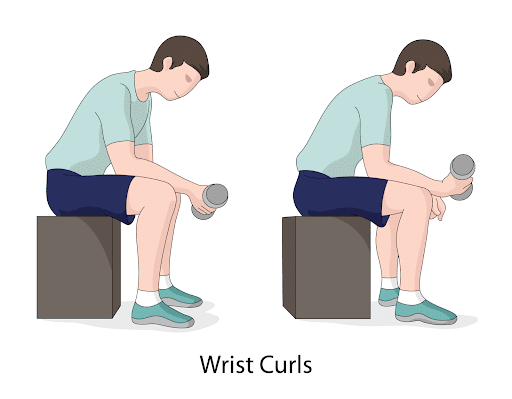
Wrist curls are a good exercise to build strength in the forearm. These are the steps of the wrist curl exercise. It can be done with a small weight like a dumbbell. You do not need a significant amount of weight to create a good training response. Good form is crucial.
- Take a dumbbell or barbell in one hand.
- Curl your wrists upward while exhaling in a very controlled motion.
- In a controlled, slow motion, extend the wrist downwards as is comfortable while inhaling.
- Return to the neutral position.
2. Isometric Wrist Flexion
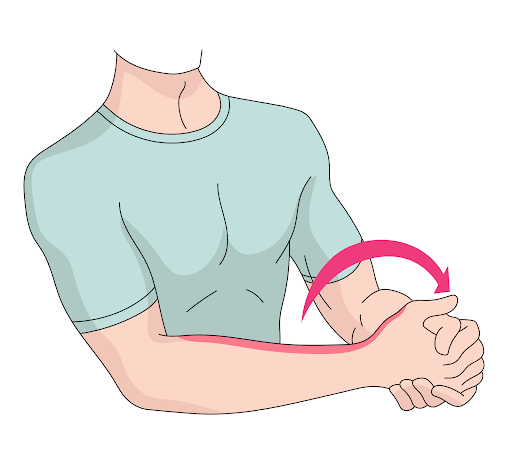
Isometric exercises are useful because you do not require any equipment and can do them on your own. The principle behind isometrics is that no movement occurs and one arm or hand will resist the other, thus creating tension and resistance.
The steps are as follows:
- Make a fist with the palm facing upwards.
- Flex the wrist in an upward direction.
- Use the other hand to resist the movement.
- Hold this position for 10 seconds.
- Return to the neutral position and repeat three or four times.
3. Isometric Wrist Extension

Similar, but opposite, to wrist flexion, these are the steps of the isometric wrist extension exercise.
- Make a fist with the palm facing upwards.
- Extend the wrist upwards.
- Use the opposite hand to resist the motion.
- Hold this position for 10 seconds.
- Return to the neutral position.
4. Resisted Wrist Flexion
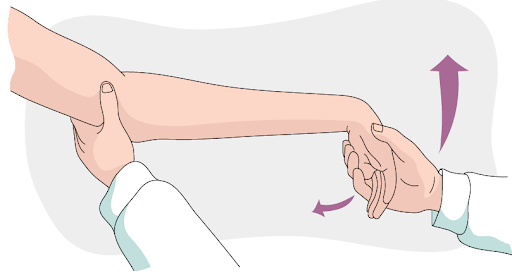
The resisted wrist flexion exercise can be done in various ways using resistance bands and with a small weight, which could be a weight or a ball.
Using Resistance Bands
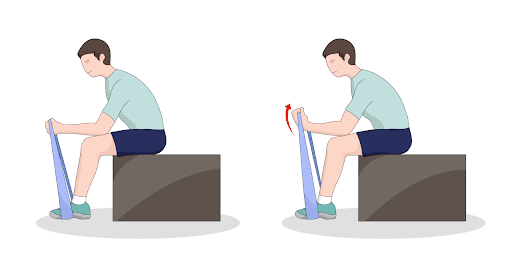
Here are the steps of the resisted wrist flexion exercise with resistance bands. While I’m not the biggest fan of using bands for all exercises, it can be useful if dumbbells or other machines are not available.
- Step on the resistance bands while seated.
- Hold the resistance band.
- Curl the fist upwards.
- Hold for five seconds.
- Lower the wrist and return to the neutral position.
- Repeat this about ten times.
Using Weights or Ball
Here are the steps of the resisted wrist flexion exercise with weight. You need a table for this.
- Hold your forearm on a table with the palm facing upwards slightly off the table’s edge.
- Curl the fist upwards.
- Lower the wrist and return to the neutral position.
- Repeat this about 10 times.
- If able, add weight in the next rep and follow the steps above.
5. Resisted Wrist Extension
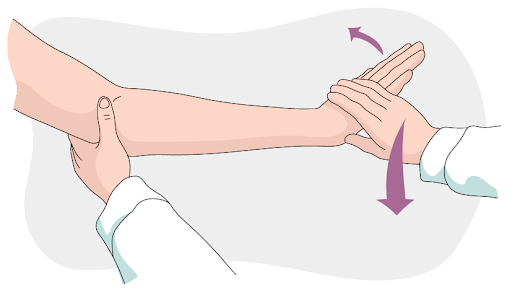
The resisted wrist extension exercise can be done in various ways using resistance bands and with a small weight, which could be a weight or a ball. This exercise can be combined with the resided wrist flexion exercise alternating between flexion and extension.
Using Weights or Ball
Here are the steps of the resisted wrist extension exercise with weight. You need a table for this.
- Hold your forearm on a table with the palm facing upwards slightly off the table’s edge.
- Curl the fist downwards.
- Raise the wrist and return to the neutral position.
- Repeat this about 10 times.
- If able, add weight in the next rep and follow the steps above.
6. Forearm Supination/Pronation
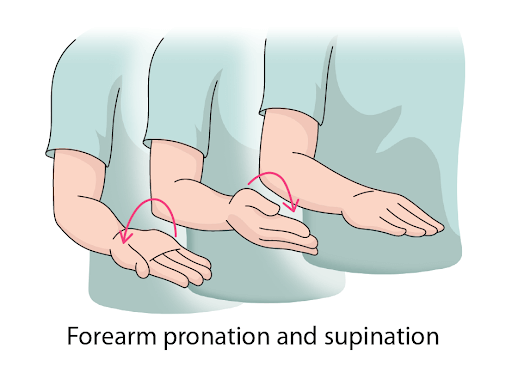
Here are the steps of the forearm supination/pronation exercise:
- Place your hand in a palm upwards position or supinated position.
- In a controlled fashion, slowly rotate your hand to a palm downwards or pronated position.
- Do 15 reps of this alternating position.
- You can add small dumbbells to increase resistance if desired.
7. Shoulder Wall Slider

For the shoulder wall slider exercise you need a solid wall. Here are the steps.
- Stand tall against a wall with feet shoulder-width apart.
- Bend your arms at the elbow to 90 degrees.
- Press your arms and back into the wall. Slide your hands upwards toward the ceiling.
- An adaptation to this would be to slide your back downwards, bending at the knees while your hands go upwards against the wall.
- Hold the upwards position for 10 seconds.
- Return to the neutral position.
8. Golfer’s Elbow Stretch
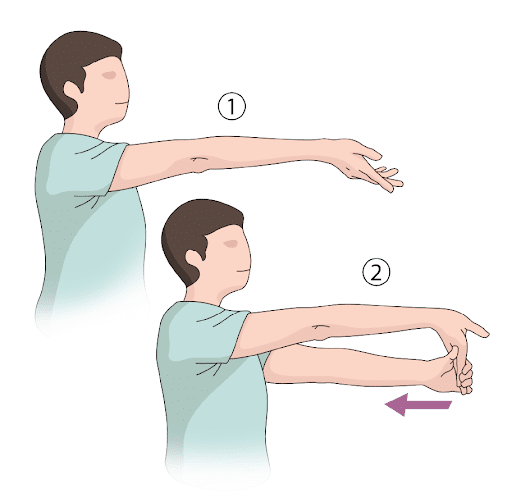
The stretching exercise for golfers’ elbow has the following steps.
- Stretch the affected arm in front with the palm facing upwards.
- Relax the wrist.
- Using the other hand, pull the affected hand back towards the body in the extended position.
- Hold for about 30 seconds and then repeat.
Exercises To Avoid If You Have Golfer’s Elbow
While there are many stretches and exercises that ease the symptoms of golfers’ elbow, here are some exercises that you should avoid.
- Heavy lifting: You should avoid heavy lifting, especially in a supinated position. Stop lifting heavy things with a palm-up position for now. This can potentially create more damage to the common flexor tendon at its origin in the elbow.
- Repetitive pulling: This can stretch out the ulnar collateral ligament that is already experiencing degeneration due to chronic flexion.
- Actions that involve your symptomatic side: Monitor your symptoms in sports like tennis, golf, badminton, ping pong, or activities that strain the wrist flexors and the elbow joint.
- Movements that aggravate forearm muscles: Movements that aggravate the forearm muscles could simply involve screwing a nail or mowing the lawn. All these forearm movements can further damage the already injured flexor tendons.
When To Stop Exercising And Consult Your Doctor
While physical therapy is the first line of intervention for a golfer’s elbow, if you find yourself developing one of the following, it may be time to pause and consult an orthopedic doctor right away.
- If the exercise causes worsening pain: If the exercise causes pain that is more than just mild discomfort, then you need to be seen by a doctor.
- If the exercise worsens pain: If the pain worsens with the exercise, there may also be other injuries occurring and you need to be seen by a doctor.
- No noticeable changes in day-to-day symptoms after a few weeks of exercising: If you have been exercising for over three weeks and see no improvement in your symptoms, then seek consultation.
- Pain is recurring: If the individual has relief with physical therapy but the pain recurs after a few weeks, then it needs to be checked. Cycles of recurrent episodes of elbow pain and relief from physical therapy are signs of a worsening injury that should be further investigated.
- Development of other symptoms: If you develop any of the following symptoms, they are signs of a neurologic or systemic condition and must be seen by a doctor immediately.
- Tingling along the distribution of the ulnar nerves
- Numbness or a lack of sensation along the forearm
- Progressive weakness of the forearm and wrist
- Swelling of the elbow joint or the forearm
- Fever above 100.4॰F
- Redness or warmth in the elbow joint or the forearm muscles
- Immobility of the arm or inability to flex or extend the wrist
- Visible deformity in the forearm.
How Does Physical Therapy For Golfer’s Elbow Help?
Physical therapy is a very effective way to treat golfer’s elbow. Stretching and strengthening exercises are a good way to treat and prevent further injury to the flexor tendon. The stretching exercises improve mobility and flexibility of the elbow joint and the forearm muscles. The strengthening exercises can restore function and strengthen the wrist, the elbow, and the forearm. This is done actively, at first with trainers, and then, passively, after a few weeks.
At Centeno-Schultz Clinic, our Physical Therapy team works with the doctors to create a physical therapy program tailored to you. Physical therapy is used in conjunction with other treatments including orthobiologics so that the healing is faster and more effective.
Free Yourself From Elbow Pain Safely And Effectively
You don’t have to live with elbow pain due to the golfer’s elbow. There are many treatment options for medial epicondylitis including prolotherapy, platelet-rich plasma therapy, and bone marrow concentrate therapy. These are regenerative therapies that may not be offered by other doctors.
At CSC, we recommend regenerative therapies instead of surgery because they can facilitate the healing of the injured tendons and ligaments. Instead of treating the symptoms only, they focus on the cause of your golfer’s elbow. Contact our board-certified doctors today to find out about the treatment options for you if you have elbow pain.
Are you a Candidate?
